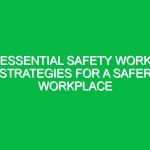Introduction
Good morning, team! Today, we’re going to dive into a topic that might seem a bit controversial at first glance: “Is Safety redundant?” While it might sound like we’re questioning the importance of Safety, this discussion is vital for understanding how to effectively integrate safety practices into our daily operations. The phrase “Safety Can Be Redundant” is often thrown around in the Health, Safety, and Environment (HSE) domain, and it’s crucial to unpack what that really means. Let’s explore how we can enhance our safety protocols, prevent accidents, and maintain a safe working environment.
Understanding the Concept: Safety Can Be Redundant
When we say that Safety Can Be Redundant, we’re not suggesting that safety practices are unnecessary. Instead, we are highlighting that sometimes Safety Measures might be excessive or improperly implemented, leading to confusion or even complacency. This redundancy can occur when:
- Safety protocols become overly complicated.
- Employees become desensitized to Safety Measures.
- Duplicative efforts lead to inefficiency.
The Importance of Streamlined Safety Protocols
One of the core principles of effective safety management is the importance of streamlined protocols. When safety measures are clear and concise, they are more likely to be followed. Excessive or redundant safety practices can create a false sense of security, where employees might overlook essential protocols because they feel overwhelmed. For example, if a workplace requires multiple layers of protective equipment for a task that only necessitates one or two, employees might become complacent, thinking that they are entirely safe when they are not.
Real-Life Example: The Overloaded Worker
Consider a scenario where a construction worker is required to wear a full-body harness, a hard hat, and Safety Goggles while performing a task on a ladder. However, the risk of falling is minimal because the ladder is stable and the worker is trained to maintain three points of contact. In this case, the overload of safety equipment can make the worker less vigilant, as they might feel overly protected and therefore less cautious. This is a classic example of how safety can become redundant.
Key Aspects of Effective Safety Protocols
To ensure safety measures are effective and not redundant, consider the following key aspects:
- Risk Assessment: Always conduct a thorough risk assessment before implementing safety measures. Understand the actual risks involved in a task and tailor safety protocols accordingly.
- Employee Training: Regular training sessions should be held to reinforce the importance of safety protocols, ensuring that all employees understand when and how to apply them effectively.
- Feedback Mechanisms: Establish channels for employees to provide feedback on safety protocols. This input can uncover redundancies and areas for improvement.
- Continuous Improvement: Safety measures should evolve based on new information, incidents, and technologies. Regularly review and update safety protocols to keep them relevant and effective.
Potential Hazards and Risks
Understanding the potential Hazards and risks associated with safety redundancy is crucial for Prevention. Here are some considerations:
- Complacency: As previously mentioned, when employees feel excessively protected, they may become complacent and neglect basic safety practices.
- Increased Risk of Accidents: Overly complicated protocols can lead to mistakes. For instance, if a worker is distracted by too many instructions, they may overlook a critical safety step.
- Legal Implications: Non-compliance with safety Regulations can result in legal repercussions for both employees and employers. It is essential to ensure that all safety measures align with local and national regulations.
Case Study: The Effect of Excessive Safety Protocols
In a manufacturing plant, safety protocols were established to prevent accidents while operating heavy machinery. However, the protocols became so extensive that workers often skipped steps due to frustration. This led to several near-miss incidents because employees felt overwhelmed. Eventually, management simplified the protocols, focusing on the most critical safety measures, which significantly improved adherence and reduced incidents.
Best Practices for Effective Safety Management
Now that we’ve discussed potential hazards and the importance of streamlined safety protocols, let’s look at some Best Practices that can help us maintain a safe working environment without falling into the trap of redundancy:
- Keep It Simple: Always aim for simplicity in safety protocols. The easier they are to understand, the more likely employees will follow them.
- Engage Employees: Involve employees in the development and review of safety protocols. They can provide valuable insights and may identify areas where redundancy exists.
- Regular Refresher Courses: Schedule ongoing training and refresher courses to keep safety top of mind without overwhelming employees.
- Utilize Technology: Use technology to streamline safety reporting and monitoring processes, making it easier for employees to comply with protocols.
Encouraging Open Dialogue
As we wrap up this Toolbox Talk, I want to emphasize the importance of open dialogue about safety in our workplace. What are your thoughts on safety redundancy? Have you encountered situations where safety measures felt excessive or confusing? I encourage you to share your experiences and suggestions.
Regulations and Standards
It’s essential to remember that our safety protocols must align with relevant regulations and standards. Compliance not only protects our employees but also safeguards the company from legal liabilities. Make sure you’re familiar with the Occupational Safety and Health Administration (OSHA) standards and any specific regulations that apply to our industry. Remember, understanding these regulations is not just about compliance; it’s about creating a culture of safety.
How Compliance Impacts Safety
Compliance with safety regulations can significantly impact our overall safety culture. When employees see that safety is prioritized and that we adhere to regulations, it fosters a sense of trust and accountability. It’s also crucial for creating a work environment where everyone feels responsible for safety, rather than viewing it as a burden.
Conclusion
In conclusion, while we acknowledge that Safety Can Be Redundant, our goal is to ensure that our safety measures are effective, relevant, and efficient. By streamlining our protocols, engaging employees, and encouraging open dialogue, we can foster a culture of safety that truly protects everyone. Thank you for your attention today and for your ongoing commitment to maintaining a safe working environment. Remember, safety is a collective responsibility, and together, we can make a difference!


